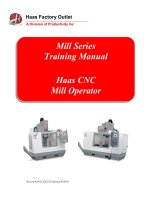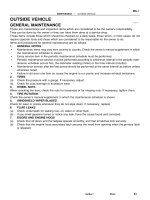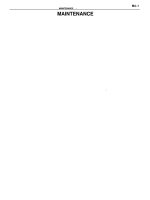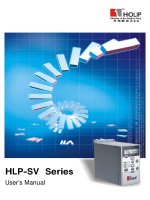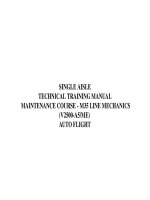90205 1140DEF b series inspection maintenance manual
Bạn đang xem bản rút gọn của tài liệu. Xem và tải ngay bản đầy đủ của tài liệu tại đây (4.49 MB, 62 trang )
B Series
Inspection & Maintenance
Manual
Kawasaki Heavy Industries, Ltd.
90205 1140DEF
B Series
Kawasaki Robot
Inspection and Maintenance Manual
PREFACE
This manual describes inspection and maintenance procedures for Kawasaki Robot B Series.
Read and understand the contents of this manual and the safety manuals thoroughly, and strictly
observe all rules for safety before proceeding with any operation.
Never proceed with any operation until you understand the contents of this manual completely.
Kawasaki is not responsible for any accidents and/or damages resulting from operations/
maintenance based on only a limited reading or limited understanding of some parts of this
manual.
This manual is applicable to the following robot arms.
BX100S, BX100N, BX100L, BX130X, BX165N, BX165L
BX200L, BX250L, BX300L, BT165L, BT200L
1. This manual does not constitute a guarantee of the systems in which the robot is utilized.
Accordingly, Kawasaki is not responsible for any accidents, damages, and/or problems
relating to industrial property rights as a result of using the system.
2. It is recommended that all personnel assigned for activation of operation, teaching,
maintenance or inspection of the robot attend the necessary education/training course(s)
prepared by Kawasaki, before assuming their responsibilities.
3. Kawasaki reserves the right to change, revise, or update this manual without prior notice.
4. This manual may not, in whole or in part, be reprinted or copied without the prior written
consent of Kawasaki.
5. Store this manual with care and keep it available for use at any time. If the robot is
reinstalled or moved to a different site or sold off to a different user, attach this manual to the
robot without fail. In the event the manual is lost or damaged severely, contact Kawasaki.
Copyright © 2016 Kawasaki Heavy Industries Ltd. All rights reserved.
1
B Series
Kawasaki Robot
Inspection and Maintenance Manual
SYMBOLS
The items that require special attention in this manual are designated with the following symbols.
Ensure proper and safe operation of the robot and prevent physical injury or property damages by
complying with the safety matters given in the boxes with these symbols.
DANGER
Failure to comply with indicated matters can result
in imminent injury or death.
WARNING
Failure to comply with indicated matters may
possibly lead to injury or death.
CAUTION
Failure to comply with indicated matters may lead
to physical injury and/or mechanical damage.
[ NOTE ]
Denotes precautions regarding robot specification,
handling, teaching, operation, and maintenance.
WARNING
1. The accuracy and effectiveness of the diagrams, procedures, and detail
explanations given in this manual cannot be confirmed with absolute
certainty. Accordingly, it is necessary to give one’s fullest attention when
using this manual to perform any work. Should any unexplained
questions or problems arise, please contact Kawasaki.
2. Safety related contents described in this manual apply to each individual
work and not to all robot work. In order to perform every work in safety,
read and fully understand the safety manual, all pertinent laws, regulations
and related materials as well as all the safety explanations described in
each chapter, and prepare safety measures suitable for actual work.
2
B Series
Kawasaki Robot
Inspection and Maintenance Manual
CONTENTS
Preface.............................................................................................................................................. 1
Symbols............................................................................................................................................ 2
1.0
Precautions............................................................................................................................ 5
2.0
Items of Maintenance & Inspection.................................................................................... 14
3.0
Details of Daily Check........................................................................................................ 18
4.0
4.1
4.2
4.3
4.4
4.5
4.6
Grease Replacement for Reduction Units .......................................................................... 19
JT1 Reduction Unit............................................................................................................. 20
JT2 Reduction Unit............................................................................................................. 23
JT3 Reduction Unit............................................................................................................. 26
JT4 Reduction Unit............................................................................................................. 29
JT5 Reduction Unit............................................................................................................. 32
JT6 Reduction Unit............................................................................................................. 35
5.0
5.1
5.2
5.3
Check of Timing Belt ......................................................................................................... 38
Check Procedure................................................................................................................. 40
Readjustment Procedure ..................................................................................................... 40
Replacement Procedure (Unused Items) ............................................................................ 41
6.0
Check of Motor Brake Torque............................................................................................ 42
7.0
Check of Internal Machine Cables and Tubes.................................................................... 43
8.0
8.1
8.2
8.3
8.4
Check of Gas Spring........................................................................................................... 44
Check of Gas Pressure........................................................................................................ 45
Gas Replenishment ............................................................................................................. 49
Gas Discharging.................................................................................................................. 51
Check of Rod Section ......................................................................................................... 53
9.0
Grease Replenishment for Balancer Bearing...................................................................... 55
10.0
Battery Replacement on 1HG Board.................................................................................. 56
3
B Series
Kawasaki Robot
11.0
Inspection and Maintenance Manual
Retightening........................................................................................................................ 57
4
B Series
Kawasaki Robot
1. Precautions
Inspection and Maintenance Manual
1.0 PRECAUTIONS
Prior to starting maintenance on a Kawasaki robot, pay attention to the following matters to
ensure safety.
WARNING
1. Prior to starting maintenance, turn OFF the controller power switch and the
external power switch for shutting off power supply to the robot controller.
Display signs indicating clearly “Inspection and maintenance in progress”, and
lockout/tagout the external power switch to prevent accidents of electric shock,
etc. caused when personnel accidentally turns ON the power.
2. If changing the joint angle is required for grease replenishment, etc., first, turn
ON the motor power. Then, set the arm to the specified pose. Be careful not to
be caught by or between any moving parts of the arm due to careless approach to
the arm at this time. After moving the arm to the desired pose, turn OFF the
controller and external power. Display signs indicating clearly “Inspection and
maintenance in progress”, and lockout/tagout the external power switch before
starting maintenance.
3. Some arm parts may be very hot after continuous operations, depending on
ambient temperature when conducting maintenance immediately after the
continuous operations. Be sure the arm has cooled before starting any work.
Handling hot machine parts is extremely dangerous and may result in injury,
burns, etc.
4. Warning labels are affixed to the arm to identify areas with possibility of electric
shock, high temperature or pinching, so check these areas beforehand. See the
next pages for the warning labels and their positions.
CAUTION
1. Do not apply excessive force to the robot arm while robot is not operating.
Applying excessive force may result in a shortened service life and/or damage to
parts or the brake mechanisms in the joints.
2. Use only Kawasaki designated greases and other lubricants.
3. For replenishing and replacing grease, use manual type grease gun.
4. When using air pump type grease gun, reduce air pressure on the supply side to 0.26
Mpa (2.5 kgf/cm2) or lower by a regulator, etc. and apply grease using grease pump
P3L (manu. by Macnaught, pump ratio 50:1, part No.:50154-0349). (When using
all other grease pump models/brands, contact Kawasaki before using.)
5. Never remove any bolts unless specifically instructed by the maintenance or
inspection procedure.
5
B Series
Kawasaki Robot
1. Precautions
Inspection and Maintenance Manual
Hazardous places for high temperature and electric shock (BX100S, BX100N)
Hazardous place for
high temperature
Hazardous place for
electric shock
6
B Series
Kawasaki Robot
1. Precautions
Inspection and Maintenance Manual
Hazardous places for high temperature and electric shock (BX100L, BX130X,
BX165N, BX165L, BX200L)
Hazardous place for
high temperature
Hazardous place for
electric shock
7
B Series
Kawasaki Robot
1. Precautions
Inspection and Maintenance Manual
Hazardous places for high temperature and electric shock (BX250L, BX300L)
Hazardous place for
high temperature
Hazardous place for
electric shock
8
B Series
Kawasaki Robot
1. Precautions
Inspection and Maintenance Manual
Hazardous places for high temperature and electric shock (BT165L, BT200L)
Hazardous place for
high temperature
Hazardous place for
electric shock
9
B Series
Kawasaki Robot
1. Precautions
Inspection and Maintenance Manual
Hazardous places for pinching (BX100S, BX100N)
Hazardous place
for pinching
10
B Series
Kawasaki Robot
1. Precautions
Inspection and Maintenance Manual
Hazardous places for pinching (BX100L, BX130X, BX165N, BX165L, BX200L)
Hazardous place
for pinching
11
B Series
Kawasaki Robot
1. Precautions
Inspection and Maintenance Manual
Hazardous places for pinching (BX250L, BX300L)
Hazardous place
for pinching
12
B Series
Kawasaki Robot
1. Precautions
Inspection and Maintenance Manual
Hazardous places for pinching (BT165L, BT200L)
Hazardous place
for pinching
13
B Series
Kawasaki Robot
2. Items of Maintenance & Inspection
Inspection and Maintenance Manual
2.0 ITEMS OF MAINTENANCE & INSPECTION
For robot maintenance & inspection, there are daily checks, routine inspections (every 5000 hours
and 10000 hours) and overhaul.
This manual describes items to be maintained and inspected, as well as inspection methods and
adjustment methods. These items are very important for using the robot successfully for a long
time in a stable condition. Thus, conduct the following maintenance and inspections without
fail.
Maintenance period
Items
Daily
Inspection
Every
5000
hours
Every
10000
hours
40000
hours
Reference
Page
Exterior of robot
Robot movement & abnormal noises
Positioning accuracy of robot
Grease replenishment for reduction
units
19-37
Check of timing belts
38-41
Check of motor brake torque
42
Check of internal machine cables
and tubes
43
44-54
Check of gas spring*
Grease replenishment for balancer
bearings*
55
Battery replacement on 1HG board
56
57-59
Retightening
Overhaul
NOTE* Applicable to BX100L, BX130X, BX165N, BX165L, BX200L, BX250L, BX300L,
BT165L and BT200L.
Replace the gas spring roughly every 15000 hours or when it becomes difficult to keep
the specified pressure after the gas replenishment. (See 8.1.) However, the service
life of the gas spring is only a rough indication and it actually depends on peripheral
operating environment.
CAUTION
If the maintenance is not made as specified, it may result in a shortened service
life of robot and it may require unexpected number of replacement parts at
overhaul (approx. every 40000 hours). In addition, it is recommended to
replace seal parts such as oil seal in overhaul. Upon reaching the 40000-hour
overhaul period, contact your nearest Kawasaki service center.
14
B Series
Kawasaki Robot
2. Items of Maintenance & Inspection
Inspection and Maintenance Manual
1. Inspection items for BX100S and BX100N
Every 10000 hours
Grease replacement for reduction
units
Check of timing belts
Check of internal machine cables and
tubes
Battery replacement on 1HG board
*
Sheet
* Figure of internal machine
15
B Series
Kawasaki Robot
2. Items of Maintenance & Inspection
Inspection and Maintenance Manual
2. Inspection items for BX100L, BX130X, BX165N, BX165L, BX200L, BT165L and
BT200L
Every 10000 hours
Grease replacement for reduction
units
Check of timing belts
Check of internal machine cables and
tubes
Grease replenishment for balancer
bearings
Battery replacement on 1HG board
Every 5000 hours
Check of gas spring
*
Sheet
* Figure of internal machine
16
B Series
Kawasaki Robot
2. Items of Maintenance & Inspection
Inspection and Maintenance Manual
3. Inspection items for BX250L and BX300L
Every 10000 hours
Grease replacement for reduction
units
Check of timing belts
Check of internal machine cables and
tubes
Grease replenishment for balancer
bearings
Battery replacement on 1HG board
Every 5000 hours
Check of gas spring
17
B Series
Kawasaki Robot
3. Details of Daily Check
Inspection and Maintenance Manual
3.0 DETAILS OF DAILY CHECK
When daily maintenance and inspection of the Kawasaki robot is required, see the table below.
No. Maintenance items
Details of maintenance
Troubleshooting
1
Exterior of robot
1. Check for damage to robot
parts, due to interference etc.,
especially wrist section.
1. Remove the cause of
interference, etc.
2
Cables and hoses
1. Remove the cause of trouble
by readjusting the clamps, etc.
3
Robot motion
1. Check for severe bending,
twisting, damage, etc. on the
cables, hoses and other
component parts connected
with the tool.
1. Check if each axis moves
smoothly.
2. Check if any abnormal noise
and/or vibrations are
observed.
3. Check if the overshoot is
excessively large.
4
Positioning
accuracy
1. Check if any drift from
previously repeated positions
is observed.
2. Check if any fluctuations are
observed in the stop position.
5
Safety systems
1. Check if the safety systems
(Emergency, Deadman,
Safety Fence switches, etc.)
can be operated normally.
1. Check the lubrication level.
2. Check if any abnormality is
observed in the driving
system.
3. If the backlash has increased
and thus resulted in vibration,
contact nearest Kawasaki
service center.
1. Check if any abnormality is
observed in the driving
system.
2. If the backlash has increased
and thus resulted in vibration,
contact nearest Kawasaki
service center.
1. Check switches and wiring for
problems and remove the
cause.
If the above abnormalities cannot be corrected by mechanical troubleshooting, contact Kawasaki
for control system inspection and adjustment.
18
B Series
Kawasaki Robot
4. Grease Replacement for Reduction Units
Inspection and Maintenance Manual
4.0 GREASE REPLACEMENT FOR REDUCTION UNITS
WARNING
1. Prior to replacing/replenishing the grease and oil, turn OFF the controller
and external power switches. Display signs indicating clearly “Inspection
and maintenance in progress” and lockout/tagout the external power switch
to prevent personnel from accidentally turning ON the power.
2. Prior to replacing or replenishing the grease, remove the plug from drain
port without fail. If grease is replenished without removing the drain plug,
internal pressure increase by replenishing the grease may damage the sealing
or cause grease to flow into the motor.
CAUTION
1. When replacing/replenishing grease, maintain the specified refill level; do not
apply too much grease.
2. Use a hand-pump type grease gun to replace or replenish the grease.
3. When using air pump type grease gun, reduce air pressure on the supply side
to 0.26 Mpa (2.5 kgf/cm2) or lower by a regulator, etc. and apply grease using
grease pump P3L (manu. by Macnaught, pump ratio 50:1, part
No.:50154-0349). (When using all other grease pump models/brands,
contact Kawasaki before using.)
4. When replenishing grease, do not connect a long hose for drainage to the
drain port directly, or grease may not drain smoothly and may leak out
resulting in seal’s inside out or coming off due to increased pressure by
replenishing.
5. Observe the latest MSDS of the grease before grease replenishment.
6. When replacing/replenishing grease, prepare a container and rags in advance
to catch the spilled grease. The grease might leak from filler port and drain
port.
[ NOTE ]
Use a hexagonal wrench or a torque wrench with hexagonal-bar
attachment whose size is shown below for mounting/removing a plug.
Plug
R1/8
R1/4
R3/8
Width across flat of tool [mm]
5
6
8
19
B Series
Kawasaki Robot
4. Grease Replacement for Reduction Units
Inspection and Maintenance Manual
4.1 JT1 REDUCTION UNIT
WARNING
Read WARNING and CAUTION in 4.0 before starting operation.
Model
Volume
Grease
Working location
BX100S, BX100N, BX100L, BX130X, BX165N,
BX250L, BX300L
BX165L, BX200L, BT165L, BT200L
3750 cc (Approx.)
6400 cc (Approx.)
Moly White A
-1 (See 2.0-1, 2.0-2 and 2.0-3.)
BX100S, BX100N, BX100L, BX130X
BX165N, BX165L, BX200L, BT165L
BT200L
BX250L, BX300L
Filler port
Filler port
Drain port
Drain port
Grease replenishment jig with grease nipple [50154-0140]
20
B Series
Kawasaki Robot
4. Grease Replacement for Reduction Units
Inspection and Maintenance Manual
Procedure
1. Remove the plug (R1/4) from the filler port and attach the grease replenishment jig with
grease nipple (R1/4) shown in the above figure.
2. Put a container for drained grease and remove the plug (R3/8) from the drain port.
[ NOTE ]
The pressure in the grease bath may be increased due to the influence of
temperature change, etc. and grease may be disgorged. Cover each port with a
rag, etc. so that grease may not spatter when removing the plug.
3.
Supply specified amount of grease from the filler port until only new grease comes out.
[ NOTE ]
1. The amounts of grease should be the same in supply and drainage. To check
the amounts, catch the drained grease with bag or container without fail.
2. Keep the difference between supplied amount and drained amount within ±5 %
of the specified supply amount (BX250L/BX300L: ±320 cc, Other than
BX250L/BX300L: ±190 cc).
4.
5.
6.
7.
Return the plug to the drain port (temporary joint).
Remove the grease nipple from the filler port.
Measure the amount of drained grease (volume or mass).
Adjust the amount of grease so that the amount of grease supplied and that of grease drained
are the same.
When the amounts of grease supplied and drained are the same, move to 8.
When the amount of grease supplied is smaller than that of grease drained, move to a.
When the amount of grease supplied is larger than that of grease drained, move to d.
[When the amount of grease supplied is smaller than that of grease drained]
a. Remove the plug from the drain port and attach a grease nipple (R3/8).
b. Add grease from the drain port. (Amount of grease to be added = Amount of grease
drained - Amount of grease supplied) If the grease comes out from the filler port
before the grease of specified amount has been replenished, attach the plug to the filler
port and move JT1 in Teach mode. Then, remove the plug from the filler port and
replenish the grease from the drain port.
c. Move to 8.
[When the amount of grease supplied is larger than that of grease drained]
d. Remove the plug from the drain port and drain the grease. (Amount of grease to be
drained = Amount of grease supplied - Amount of grease drained) If the grease does not
come out from the drain port spontaneously, move JT1 in Teach mode or connect a
regulator to the filler port and apply pressure by air until the grease comes out. Do not
apply additional pressure once the grease starts coming out.
21
B Series
Kawasaki Robot
4. Grease Replacement for Reduction Units
Inspection and Maintenance Manual
Regulator set
Part No.
49154-0007
CAUTION
Too much pressure damages seal structure in the grease bath.
The pressure of regulator applied should be 20 kPa or less.
e.
Return the plug to the drain port after the specified amount of grease comes out. When
using the regulator, reduce the pressure to 0 kPa, remove the regulator and return the
plug.
f. Move to 8.
8. Move the axis backwards and forwards individually 2 or 3 times in teach mode after the
grease replenishment.
9. Return the plug* to the filler port.
10. Remove the plug or the grease nipple from the drain port and return the plug*.
11. Wipe away any grease around the filler and drain ports with the rag.
NOTE* Grease port plugs are coated with sealant. To prevent grease leakage, it is
recommended to use sealant tape when returning the plug or to replace the plugs with
new ones at every grease replacement.
22
B Series
Kawasaki Robot
4. Grease Replacement for Reduction Units
Inspection and Maintenance Manual
4.2 JT2 REDUCTION UNIT
WARNING
Read WARNING and CAUTION in 4.0 before starting operation.
Model
Volume
Grease
Working location
BX100S, BX100N, BX100L, BX130X, BX165N,
BX250L,BX300L
BX165L, BX200L, BT165L, BT200L
1920 cc (Approx.)
2050 cc (Approx.)
Moly White A
-2 (See 2.0-1, 2.0-2 and 2.0-3.)
BX100S, BX100N, BX100L, BX130X, BX165N, BX165L, BX200L, BT165L, BT200L
Filler port
Drain port
BX250L, BX300L
Filler port
Drain port
23
B Series
Kawasaki Robot
4. Grease Replacement for Reduction Units
Inspection and Maintenance Manual
Procedure
1. Move the robot so that the JT2 becomes 0°, and then turn OFF the power.
2. Remove the plug (R1/4) from the filler port and attach a grease nipple (R1/4).
3. Put a container for drained grease and remove the plug (R3/8) from the drain port.
[ NOTE ]
The pressure in the grease bath may be increased due to the influence of
temperature change, etc. and grease may be disgorged. Cover each port with a
rag, etc. so that grease may not spatter when removing the plug.
4.
Supply specified amount of grease from the filler port until only new grease comes out.
[ NOTE ]
1. The amounts of grease should be the same in supply and drainage. To check
the amounts, catch the drained grease with bag or container without fail.
2. Keep the difference between supplied amount and drained amount within ±5 %
of the specified supply amount (±100 cc).
5.
6.
7.
8.
Return the plug to the drain port (temporary joint).
Remove the grease nipple from the filler port.
Measure the amount of drained grease (volume or mass).
Adjust the amount of grease so that the amount of grease supplied and that of grease drained
are the same.
When the amounts of grease supplied and drained are the same, move to 9.
When the amount of grease supplied is smaller than that of grease drained, move to a.
When the amount of grease supplied is larger than that of grease drained, move to d.
[When the amount of grease supplied is smaller than that of grease drained]
a. Remove the plug from the drain port and attach a grease nipple (R3/8).
b. Add grease from the drain port. (Amount of grease to be added = Amount of grease
drained - Amount of grease supplied) If the grease comes out from the filler port
before the specified amount of grease has been replenished, attach the plug to the filler
port and move JT2 in Teach mode. Then, remove the plug from the filler port and
replenish the grease from the drain port.
c. Move to 9.
24

